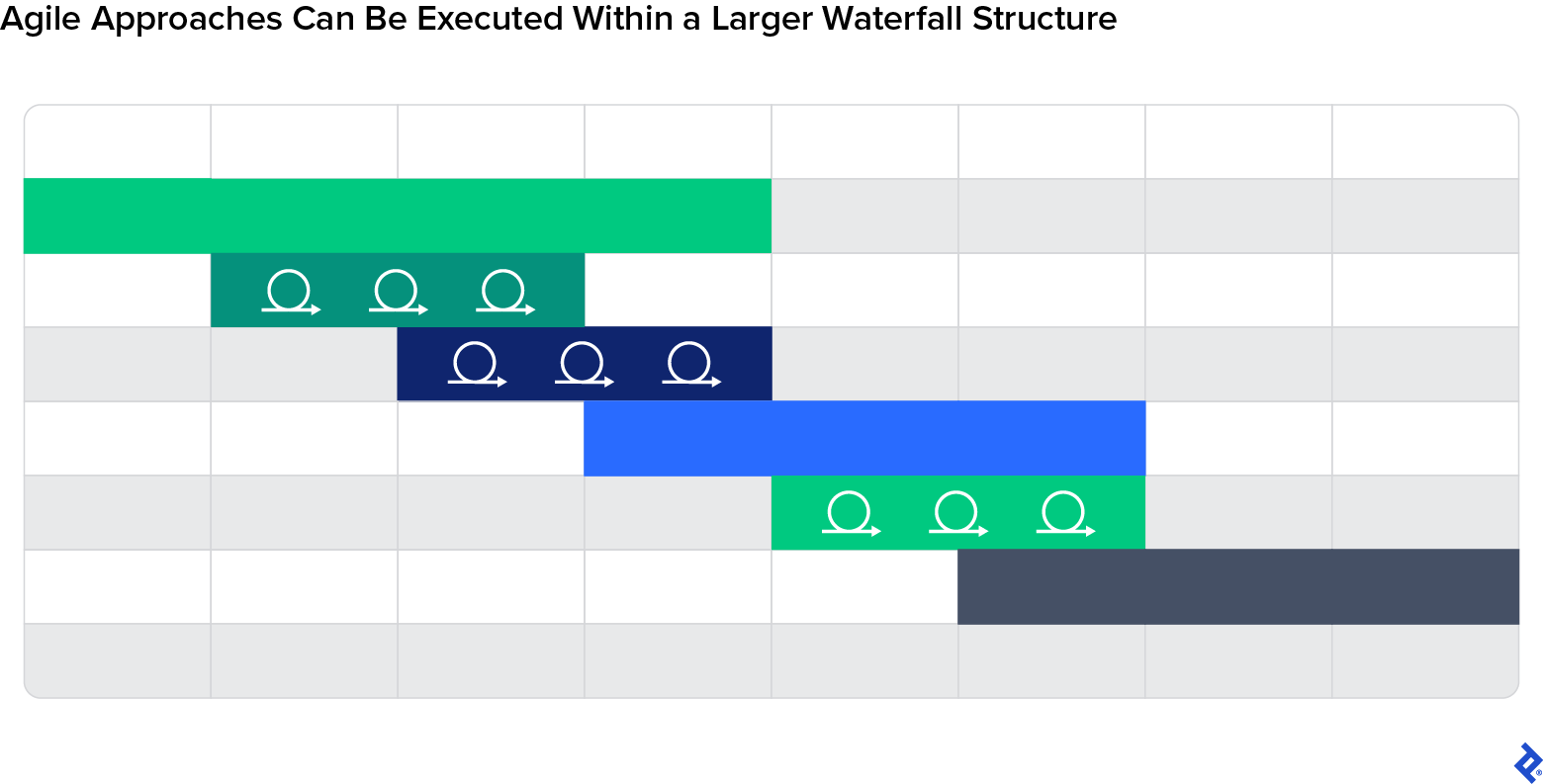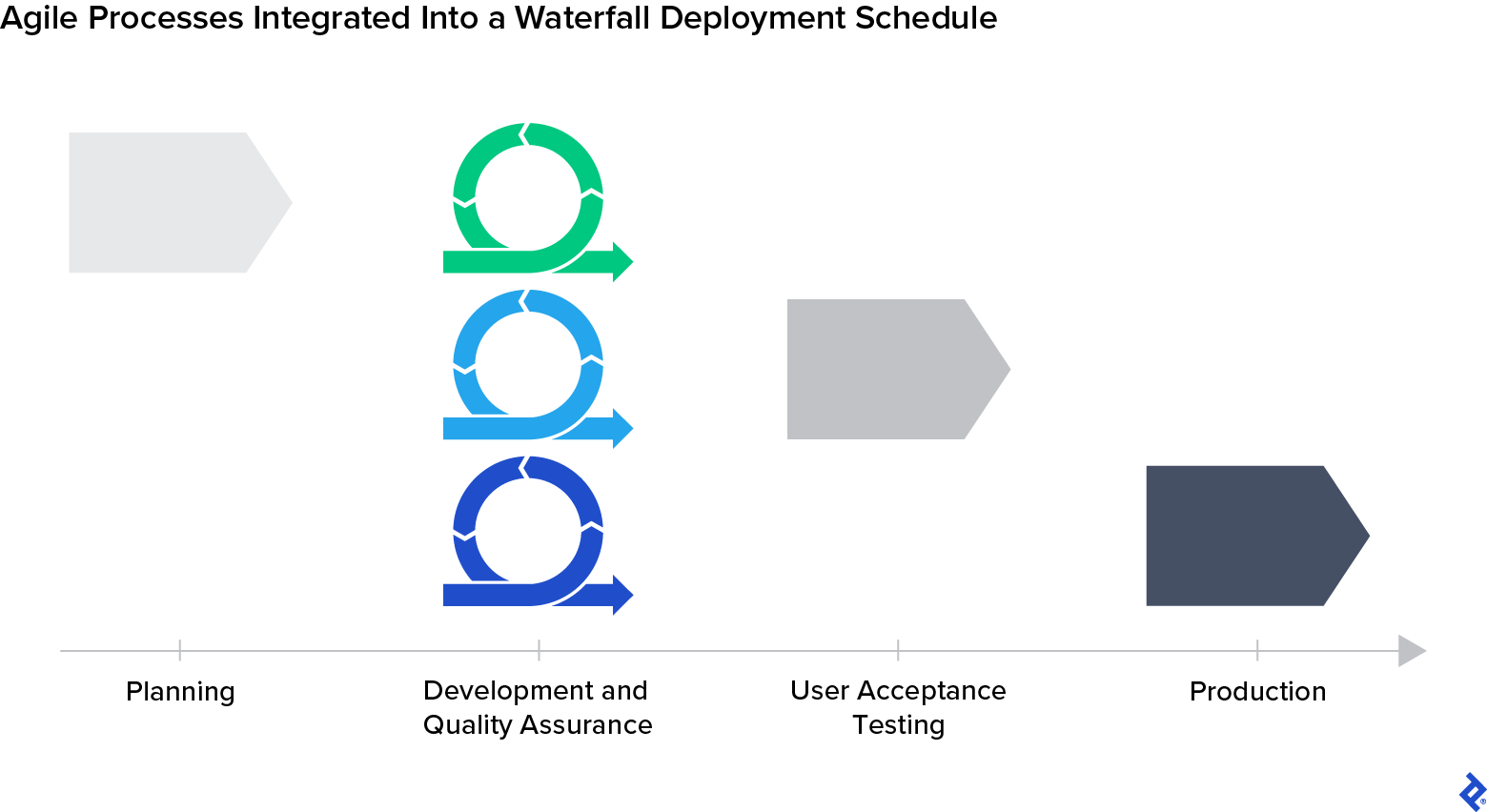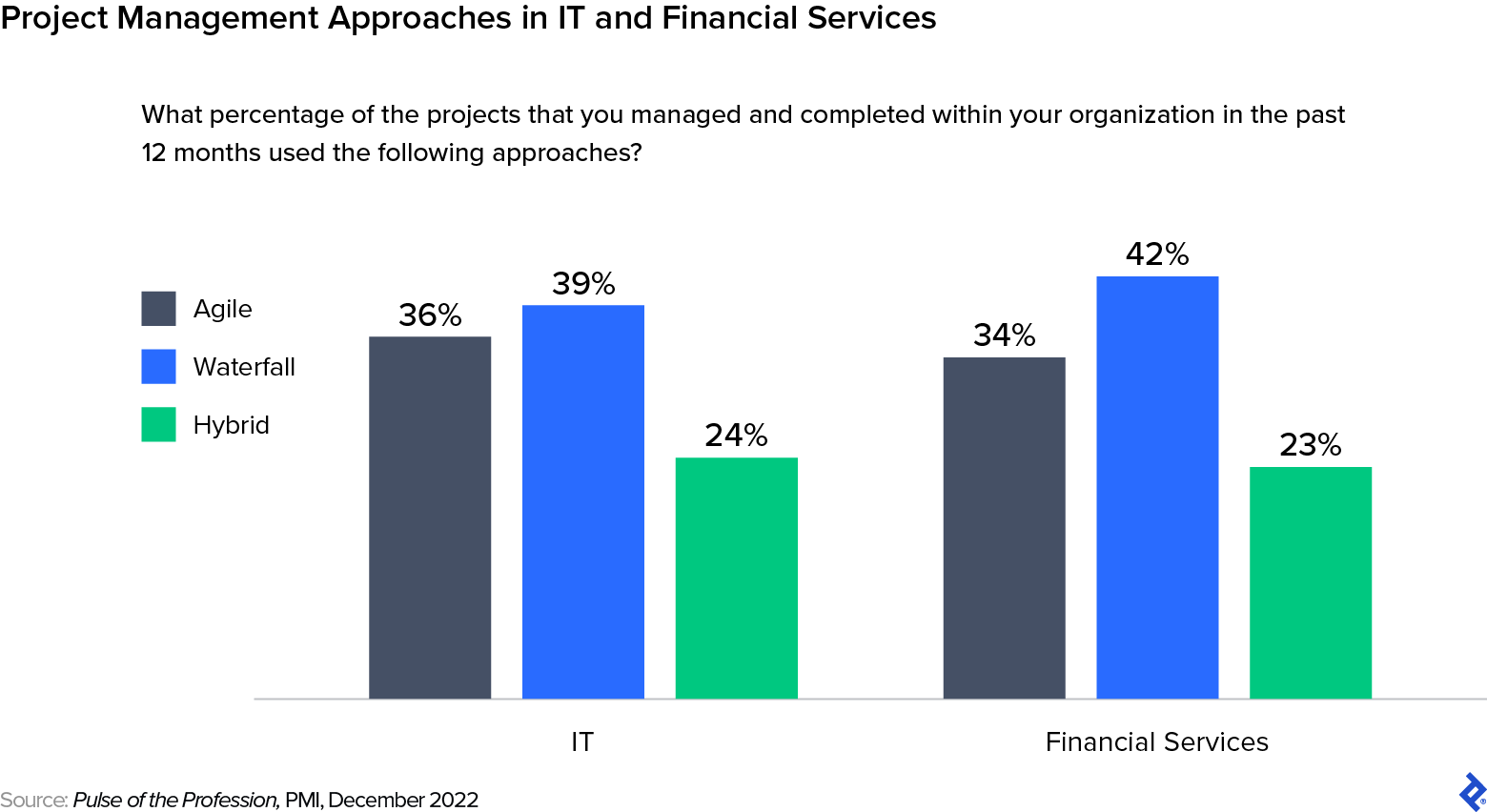Traversing Hybrid Project Management: The Bridge Between Agile and Waterfall
A hybrid approach that bridges Agile’s adaptability and Waterfall’s predictability can be challenging to implement but beneficial for some projects. Toptal project experts share their notes from the field.
A hybrid approach that bridges Agile’s adaptability and Waterfall’s predictability can be challenging to implement but beneficial for some projects. Toptal project experts share their notes from the field.

Monica Zaleski
Monica is Lead Editor, Product and Projects, at Toptal and a former editor at the Project Management Institute. She worked in academic and business publishing for more than 15 years on book projects for the University of California Press, as well as on marketing communications projects for Microsoft, SAP, and Synnex. Monica also holds a doctorate in English.
Expertise
Featured Experts

Previously at Westum
Waterfall and Agile are often depicted as rivals: an old-guard project management methodology competing with a nimble newcomer. At its heart, the difference between them comes down to predictability versus adaptability. Waterfall strives for predictable outcomes by predetermining features at the outset and deeming projects complete only once those features are fully implemented. Agile promises adaptability, delivering a minimum viable product (MVP) and then iteratively releasing new features and collecting user feedback to guide the path of improvements.
Despite the oppositional narrative, Waterfall and Agile often exist simultaneously within organizations. In 2021, the Project Management Institute reported that the information technology and finance industries were the leading adopters of Agile. Even so, Waterfall remains prevalent, and almost one in four projects in both industries employed a hybrid methodology, according to the PMI survey.
Since its official introduction by software developers in 2001, Agile has continued to grow in popularity, even creeping into industries like construction and energy where Waterfall methodologies have remained dominant. A hybrid approach combines aspects of two different management frameworks or systems with the goal of improving efficiency. In this article, Toptal project management experts who have worked on hybrid Agile-Waterfall projects in diverse industries reflect on the challenges and benefits of hybrid project management.
What Is an Agile-Waterfall Hybrid?
“True hybrid is a combination of predictive and uncertain work,” says Jim Stewart, a Boston-area Toptal project manager, Scrum master, Agile coach, and consultant. In a hybrid model, Waterfall provides the overall structure for the well-understood, predictive aspects of the project, and Agile techniques are used for the iterative, more uncertain parts.
In this way, a company can create software in an Agile fashion but follow Waterfall for the rollout process. A financial company might develop a product with major features that must be audited and approved before release. Still, smaller parts of those features can be iterated by the development team through a series of sprints, as can other aspects of the user interface.
When it comes to determining how to implement Agile in a Waterfall environment, flexibility is key. “I don’t believe in … one-size-fits-all,” says Miroslav Anicin, a project manager based in Belgrade, Serbia. “You can’t … apply methodologies by the book. You need to know exactly how to tailor those approaches based on different factors such as team maturity, company culture, subject cultures, the type of project, the size of the team, and the size of the product.”

Why Use a Hybrid System?
Agile has proven to be more adaptive and efficient than traditional approaches. Senior executives at major international corporations widely agree that Agile is necessary for achieving strategic aims. So you might be thinking: Why would organizations continue working in Waterfall?
Risk management is a common barrier that prevents organizations from going pure Agile, especially in highly regulated industries in which projects are subject to approvals from outside organizations that require documentation and rigorous timetables. Because risk analysis must occur before project planning in these industries, changing elements of the analysis would require a fresh round of planning. “I was working for a company that ran clinical trials, and audits are crazy [in that field],” says Juan Vilmaux, a project manager based in Córdoba, Argentina. “You have to go through several processes that are defined by external authorities like the FDA. If you work in Agile, you are constantly adjusting your scope or backlog—reprioritizing it—and that can interfere with these audits.”
Toptal project manager David Machiels, based in Brussels, Belgium, notes that projects demanding privacy protections require carefully timed releases. He led a hybrid team developing an identity management platform in Microsoft Azure Active Directory for a European banking group. His team used Agile on some development steps, but because banks are loath to put information in the cloud due to data-privacy concerns, they provisioned the system on a local server. The team then followed a clear Waterfall-like order of operations. “First, you need that on-premises implementation to be done,” he says. “You also need the cloud implementation to be done. Then you can start doing the connection between the two.”
When Agile is hybridized into a Waterfall environment, large projects can be broken into epics and user stories for more flexible development. Then completed features can be released on longer time frames. “Sometimes you have what I call a big bang delivery,” says Grant Schuleman, a Toptal project manager in Johannesburg, South Africa, who has worked in financial services, banking, and stock exchanges. He describes how a team would deploy incrementally to a user acceptance testing (UAT) environment. Once all the features are signed off on in UAT, the product is released in one large deployment. “And that could take a year, depending on how big the project is,” he says.
On his largest program, Schuleman had 120 people working on 10 projects—some working in Waterfall, some in Scrum, and some hybrid. He also ran a scrum of scrums every other week to ensure that the smaller teams were aligned for the next series of sprints and working at complementary paces. The orchestration of different approaches introduced flexibility while still accommodating the organizational needs that prevented them from going full Agile.

The Hardest Part of Going Hybrid
The success of an Agile-Waterfall hybrid depends on how project managers customize processes given the situation. Project managers going hybrid must find the right blend of methodologies for the product, team, and end users—yet hybridization seldom follows a preset formula.
Often the most consequential factor in determining whether Agile can be successfully hybridized into an existing Waterfall system is the degree of buy-in from team members and other stakeholders. A team must be open to change and excited to try new things. If team members aren’t well-versed in the new process, or only think of Agile as a buzzword, they might not see a reason for change. Project managers eager to combine Waterfall and Agile must foster understanding and encourage teams and organizations to consider the methods that produce optimal results.
When Schuleman tried to integrate Agile processes into an update of a legacy application, for example, he found that the experiment wasn’t embraced by the developers, who were accustomed to working in Waterfall and didn’t understand why the work was broken into epics and user stories. Team members wanted to work on everything at once. Based on that resistance and other factors, he realized a hybrid approach wasn’t appropriate, nimbly changed course midway, and guided the team to complete the project using pure Waterfall.
Vilmaux has had similar experiences working on projects, especially those with risk management considerations. Sometimes going hybrid increases your chances of failure “because you’re getting the worst parts of both worlds. You restrict Agile, but the nature of Agile is to embrace changes and to be flexible. You start losing all of that … within a Waterfall environment, which works best in a linear fashion—fixed and deterministic—and where changes aren’t impossible but can be very costly. In adding Agile, you start pushing nonlinear things within that Waterfall world.”
In Schuleman’s and Vilmaux’s experiences, project managers wishing to follow a hybrid software development methodology need to coach their teams through new concepts. However, they must also be willing to acknowledge if hybridization isn’t working and adapt appropriately.
With these considerations in mind, hybrid done right can pay off, even in a risk-averse environment. Anicin recently led a successful hybrid project for the IFC (a member of the World Bank Group) in Bosnia and Herzegovina. The plan-driven project followed highly detailed requirements and specifications, and involved numerous organizations and government stakeholders. Yet the teams worked in Agile from the beginning, and the client ultimately received a better product for a lower cost on a quicker timeline. Anicin says, “It was hard, but it worked.”
Using Agile Hybrid As an Upgrade
As industries continue to undergo digital transformation, more companies are becoming curious about Agile. Even if a company isn’t ready to dive right in, a gradual introduction to Agile can pay dividends over time. One major reason is that Agile adapts to uncertainty, a characteristic of any project.
Agile also offers transparency. “I prefer Agile because I can see the changes,” Schuleman says. “With Waterfall, there can be a lot of smoke and mirrors: ‘We’re 20% complete,’ ‘We’re 30% complete,’ but then you’re stuck on 80% for another eight months. It’s far easier to hide problems. With Agile, you’re having daily scrums, and if a user story is sitting there for longer than it should be, it’s easy to say, ‘This thing’s not moving; what’s the problem?’”
Incorporating Agile slowly into Waterfall can provide advantages, especially when aspects of a Waterfall way of thinking currently work for the team. For instance, Waterfall can do well during the discovery and planning phases. “When we are talking about the blended approach, we are providing a much more detailed product backlog,” Anicin says. In a hybrid project, he uses this backlog to give his team a more detailed, Waterfall-esque perspective on long-term expectations for the finished product. He then onboards his team “to the product, not only to the project,” he says. “I’m expecting the whole team to understand the product details because they need to have this product ownership, which is so important.”
A company and team might not be ready to go pure Agile, but at the very least, project managers can realize considerable benefits from adding Agile practices and shorter, more frequent delivery deadlines. If a project manager is rigorous, smart, and careful about implementation, a hybrid Agile-Waterfall methodology could be just what an organization needs to upgrade a project.
This article has recently undergone a comprehensive update and rewrite to incorporate the latest and most accurate information. We wish to acknowledge Greig O’Brien’s contributions to the original article. Please note: Comments below may predate this update.
Further Reading on the Toptal Blog:
- 5 Agile Scaling Frameworks Compared: Which One Should You Use?
- Today’s Project Management Blueprint: A Comparison of Lean, Agile, Scrum, and Kanban
- What Is Agile? A Philosophy That Develops Through Practice
- The Project Management Blueprint, Part 2: A Comprehensive Comparison of Waterfall, DAD, SAFe, LeSS, and Scrum@Scale
Understanding the basics
What is a hybrid Agile-Waterfall approach?
A hybrid Agile-Waterfall approach combines aspects of both Agile and Waterfall methodologies. It provides the flexibility of Agile by adapting to changing requirements, while maintaining the defined phases and documentation of Waterfall for better project control.
Why might an organization choose a hybrid project management approach?
Companies that have to satisfy strict regulatory needs but that also want to be more innovative and adaptive to their customers’ desires are ones that could benefit from a hybrid project management approach.
What is the difference between Agile and hybrid project management?
Aspects of an Agile project management approach, such as iterative development, are used in a hybrid system, but the system also uses Waterfall project management for longer-term aspects of product planning.
What is Waterfall project management?
Waterfall is a project management approach in which phases like requirements, design, implementation, testing, and deployment are completed sequentially. Waterfall strives for predictability: A project is considered finished only when all predetermined features are completed and fully implemented.





